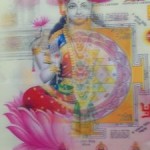Reading the Saundarya Lahari – XI
“Likely, o beloved, [by meditating on Devi] in the form of Kāmakalā emerged in the sprout of madana, with the light-circle of the rising sun, a luminous body with an expanding flame top. She exists while gulping all the beings manifested to enjoy the world.
Existing in I-ness, keeping herself within her own supreme glory, and manifesting successively down to the ground of kāma, which is within the body, manifesting in two forms whilst being alone.”
Nityāṣoḍaśikārṇava, 4.34 – 4.37 (transl. Lidke, 2000)
Now to verse 20 of Saundaryalahari:
Whoever contemplates You in his heart,
O essence of ambrosia,
abundant and radiant like an image carved in moonstone,
will quell the pride of serpents
as if he were the king of birds,
he will cure those afflicted by fever,
with the streaming nectar that showers from his glance.
(transl. Clooney, 2005, p.52)

